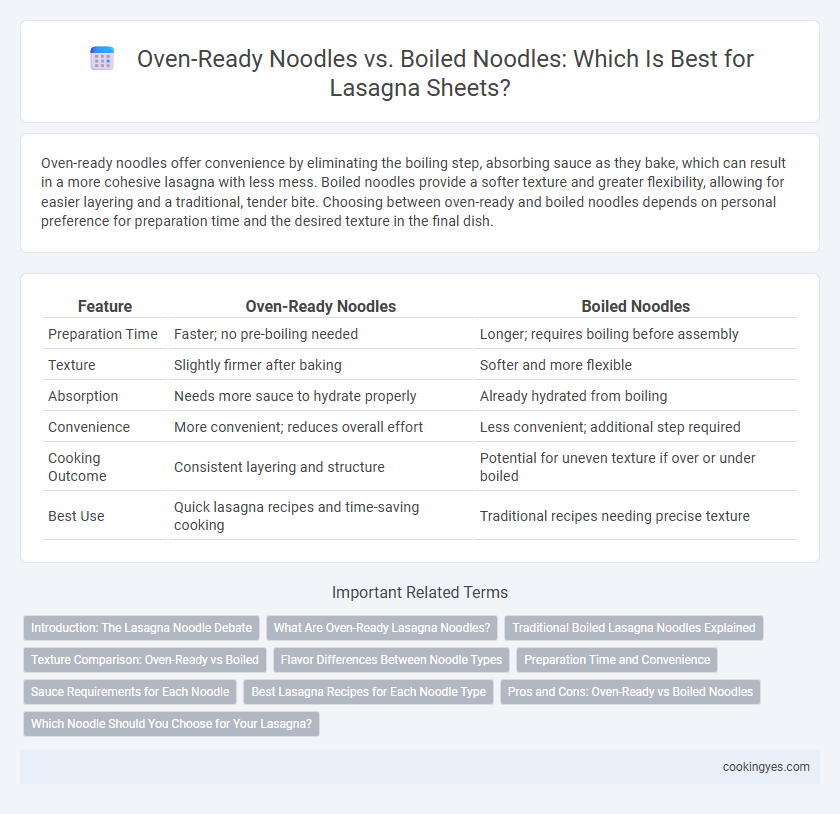Oven-ready noodles offer convenience by eliminating the boiling step, absorbing sauce as they bake, which can result in a more cohesive lasagna with less mess. Boiled noodles provide a softer texture and greater flexibility, allowing for easier layering and a traditional, tender bite. Choosing between oven-ready and boiled noodles depends on personal preference for preparation time and the desired texture in the final dish.
Table of Comparison
| Feature | Oven-Ready Noodles | Boiled Noodles |
|---|---|---|
| Preparation Time | Faster; no pre-boiling needed | Longer; requires boiling before assembly |
| Texture | Slightly firmer after baking | Softer and more flexible |
| Absorption | Needs more sauce to hydrate properly | Already hydrated from boiling |
| Convenience | More convenient; reduces overall effort | Less convenient; additional step required |
| Cooking Outcome | Consistent layering and structure | Potential for uneven texture if over or under boiled |
| Best Use | Quick lasagna recipes and time-saving cooking | Traditional recipes needing precise texture |
Introduction: The Lasagna Noodle Debate
Oven-ready noodles offer convenience by eliminating the boiling step, saving time and reducing kitchen mess, while traditional boiled noodles provide a softer texture and better sauce absorption. Boiled noodles require careful timing to avoid overcooking, which can affect the final dish's structure. Choosing between the two depends on recipe preferences and desired texture in classic Italian lasagna preparation.
What Are Oven-Ready Lasagna Noodles?
Oven-ready lasagna noodles are precooked, dried pasta sheets designed to soften directly in the oven without boiling beforehand. These noodles absorb moisture from sauces and cheese during baking, simplifying preparation and reducing cooking time. Using oven-ready noodles ensures a convenient, mess-free process while maintaining the traditional texture of classic lasagna dishes.
Traditional Boiled Lasagna Noodles Explained
Traditional boiled lasagna noodles require pre-cooking in boiling water to achieve the ideal texture, allowing them to absorb sauces evenly and prevent dryness during baking. Unlike oven-ready noodles, boiled sheets offer a tender bite and better structural integrity, ensuring layers hold together without becoming overly soft. Proper boiling time and cooling are essential to avoid sticking and maintain the perfect balance between firmness and flexibility in classic lasagna recipes.
Texture Comparison: Oven-Ready vs Boiled
Oven-ready lasagna noodles offer a firmer texture after baking as they absorb moisture directly from the sauce, maintaining distinct layers without becoming mushy. Boiled noodles provide a softer, more pliable texture, allowing for easier layering but can sometimes result in a denser, heavier final dish. Texture preference depends on the desired mouthfeel, with oven-ready noodles favoring a chewier bite and boiled noodles yielding a creamier consistency.
Flavor Differences Between Noodle Types
Oven-ready lasagna noodles offer a firmer texture and a subtle wheat flavor due to their pre-cooked, dehydrated form, which allows them to absorb sauce flavors directly during baking. Boiled noodles provide a softer, more tender bite with a mild, neutral taste that serves as a blank canvas, enhancing the prominence of rich meat, cheese, and tomato sauce layers. Flavor intensity in lasagna is often heightened with oven-ready noodles, as their slightly chewy consistency contrasts well with robust, savory fillings.
Preparation Time and Convenience
Oven-ready noodles significantly reduce preparation time by eliminating the boiling step, allowing for quicker assembly of lasagna. These noodles absorb sauce during baking, ensuring proper texture without pre-cooking. In comparison, boiled noodles require additional time for boiling and draining, making oven-ready noodles a more convenient option for efficient meal preparation.
Sauce Requirements for Each Noodle
Oven-ready noodles require more sauce since they absorb liquid during baking, ensuring the lasagna remains moist and properly cooked. Boiled noodles are pre-softened and less absorbent, so they need less sauce to prevent the dish from becoming too watery. Selecting the right sauce quantity according to the noodle type enhances texture and flavor balance in lasagna.
Best Lasagna Recipes for Each Noodle Type
Oven-ready noodles simplify preparation by absorbing moisture from sauce during baking, ideal for recipes with well-sauced fillings like classic meat or vegetable lasagna. Boiled noodles offer flexibility and a tender texture, preferred in layered recipes where precise control over noodle softness is needed, such as in creamy bechamel-based lasagnas. Choosing the best lasagna recipe depends on noodle type: oven-ready sheets suit hearty, sauce-rich versions while boiled noodles enhance delicate, evenly layered dishes.
Pros and Cons: Oven-Ready vs Boiled Noodles
Oven-ready lasagna noodles eliminate the need for pre-boiling, saving time and reducing mess while absorbing sauce during baking for a softer texture; however, they may require more sauce to cook thoroughly and risk uneven doneness if not properly hydrated. Boiled noodles offer consistent texture and control over firmness, ensuring even cooking and a traditional bite, but they add an extra step and risk sticking or tearing during preparation. Choosing between oven-ready and boiled noodles depends on balancing convenience and control in lasagna assembly and cooking.
Which Noodle Should You Choose for Your Lasagna?
Oven-ready noodles offer convenience by skipping the boiling step, absorbing sauce directly during baking to achieve a tender texture. Boiled noodles provide more control over firmness and prevent overcooking, ideal for recipes requiring layered textures. Choose oven-ready for simplicity and quicker preparation, or boiled for customized doneness and traditional consistency in your lasagna sheets.
Oven-Ready Noodles vs Boiled Noodles for Lasagna Sheets Infographic

 cookingyes.com
cookingyes.com